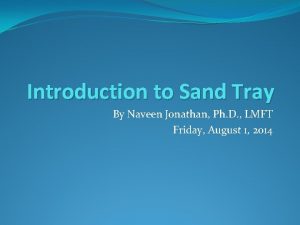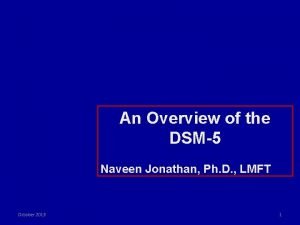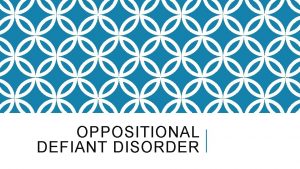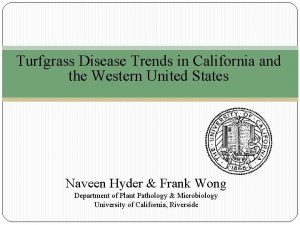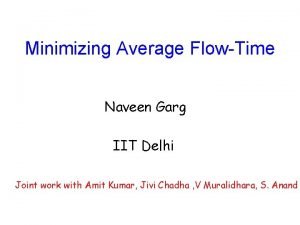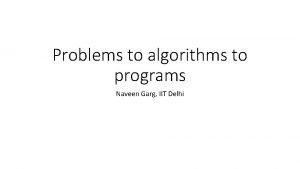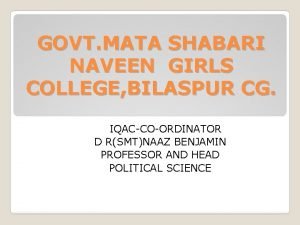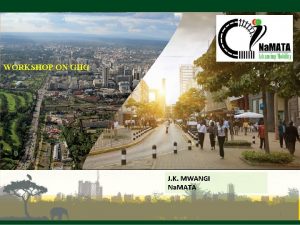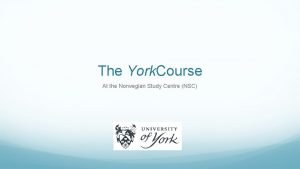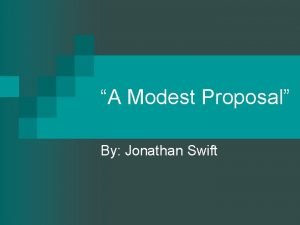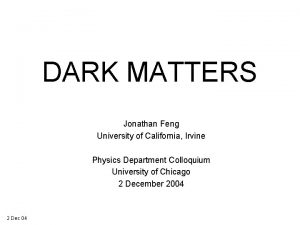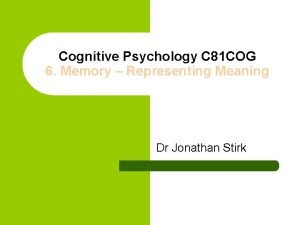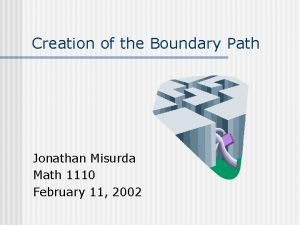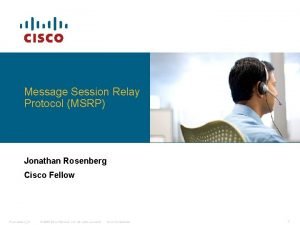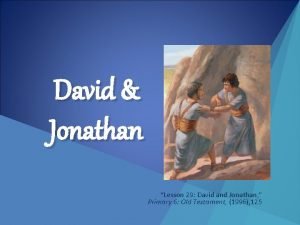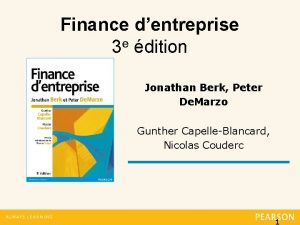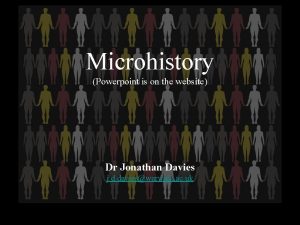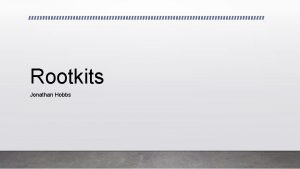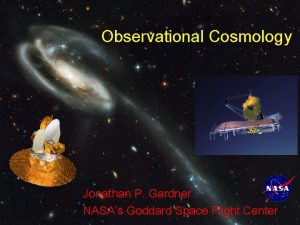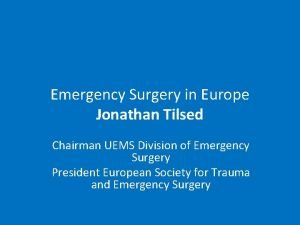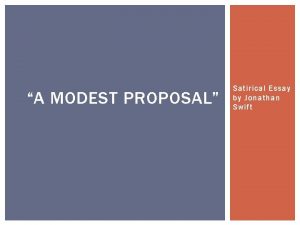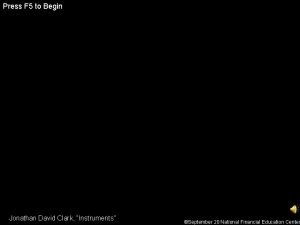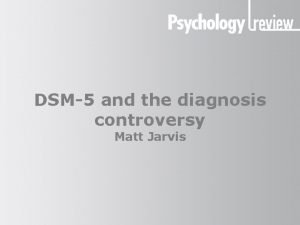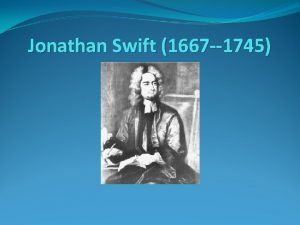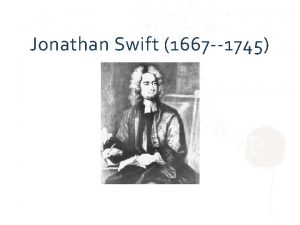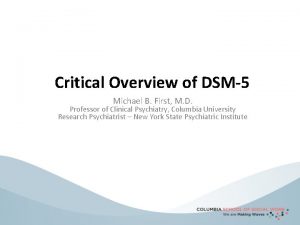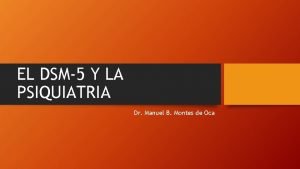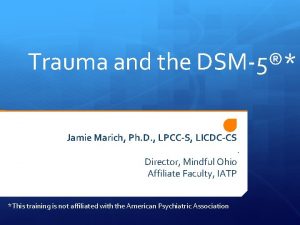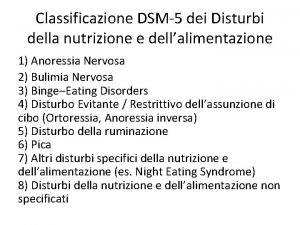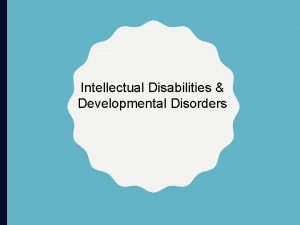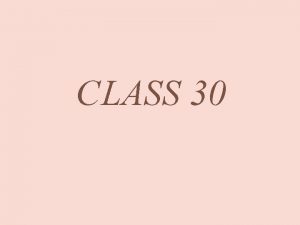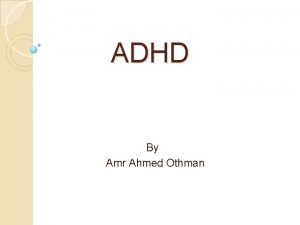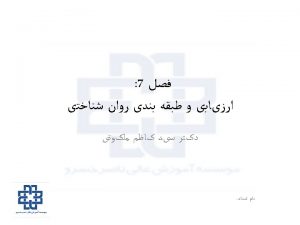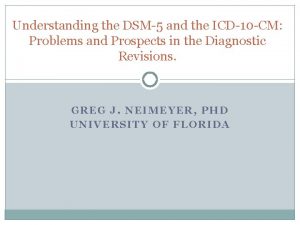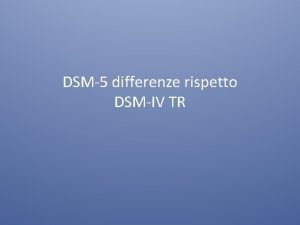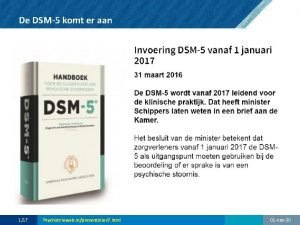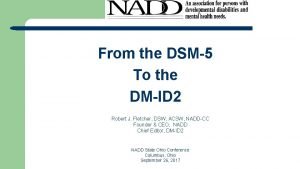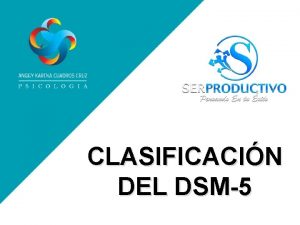An Overview of the DSM5 Naveen Jonathan Ph






































































- Slides: 70

An Overview of the DSM-5 Naveen Jonathan, Ph. D. , LMFT October 2013 1

Saying Goodbye to the DSM‐IV‐TR • https: //www. youtube. com/watch? v=h 3 nx. Gb -a. M 5 g October 2013 2

DSM-5 The following survey contains no correct or incorrect answers. The questions are posed to assist the responder in recognizing underlying beliefs regarding the practice of diagnosis in psychology. These questions have NOT been the content of formal scientific review and no conclusions should be assumed from results. Please select the score that most accurately reflects your opinion on each of the following questions: October 2013 3

DSM-5 Strongly Disagree Somewhat Strongly Disagree Agree 1 2 3 4 2. Identifying a diagnosis for a client is more helpful than harmful 1 2 3 4 3. If a client has symptoms that are in multiple diagnosis, I use the one that is the most accurate 1 2 3 4 4. I have not observed negative effects on a client due to a diagnostic label 1 2 3 4 1. A diagnosis is necessary for ethical treatment 5. I have never “fudged” on selecting a diagnosis that was marginally supported so that a client could 1 qualify for services. 6. Diagnosis is too rigid and constrained by statistics 1 October 2013 4

DSM-5 7. I would do a diagnosis for my clients even if it was not required. Strongly Disagree Somewhat Strongly Disagree Agree 1 2 3 4 8. I like reviewing GAF scores to identify progress 9. When coordinating services with treatment team members, a diagnosis helps facilitate accurate communication 10. If treatment is done properly, the label will not have any negative impacts on the client. October 2013 5

Message from Dr. Lieberman https: //www. youtube. com/watch? v=m 7 RCg. Ckr XXo Dr. Jeffrey Lieberman, chair of Columbia Psychiatry and APA's new president, gives an overview of the DSM 5 (Published on May 17, 2013) October 2013 6

DSM-5 Mental Illness as Defined -- DSM-5 “A mental illness is a condition characterized by dysfunction in thought, mood or behaviors which cause distress – The condition should not be a result of social deviance or conflict with society” DSM III DSM IV DSM-5 - October 2013 102 conditions 182 conditions 265 conditions 365 conditions 400 conditions 7

Introducing DSM 5 • Evidence Based • International Efforts • 16 years in development October 2013 8

In Summary • Format Changes that were significant – Chapter organization – Diagnosis procedure • Minor Diagnosis Changes – New ways to conceptualize and categorize former disorders – New forms of assessment – Increased amount of specifiers – No radically new criteria or disorders (15 fewer diagnosis) October 2013 9

What happened to the “V” • DSM‐ 5 (note the hyphen) • Not DSMV • What happened? – 5. 1, 5. 2, 5. 3, 5. 4 – Digital text revision – Welcome to the age of technology… October 2013 10

The Process • • Clinical Utility (highest priority) Evidence‐Based Recommendations Continuity wit DSM IV No Pre‐Determined Constraints • (Refer to dsm 5. org) October 2013 11

DSM-5 October 2013 12

DSM-5 October 2013 13

DSM-5 October 2013 14

DSM-5 October 2013 15

Cross Disorder Specifiers • With Catatonia (for neurodevelopmental psychotic, mood, etc. ) • With anxious distress (depression, bipolar) • With panic attacks (all) • With poor insight (OCD and certain anxiety) Note: there also new disorder‐specific specifiers October 2013 16

NOS vs. NEC • DSM 5 eliminates Not Otherwise Specified (NOS) – Not directly useful – Tends to be overused • Not Elsewhere Classified – Incorporates specific criteria and codes including symptoms. October 2013 17

DSM-5 October 2013 18

DSM-5 October 2013 19

DSM-5 New Disorders 1. Social (Pragmatic) Communication Disorder 2. Disruptive Mood Dysregulation Disorder 3. Premenstrual Dysphoric Disorder (DSM‐IV appendix) 4. Hoarding Disorder 5. Excoriation (Skin‐Picking) Disorder 6. Disinhibited Social Engagement Disorder (split from Reactive Attachment Disorder) 7. Binge Eating Disorder (DSM‐IV appendix) 8. Central Sleep Apnea (split from Breathing‐Related Sleep Disorder) 9. Sleep-Related Hypoventilation (split from Breathing‐Related Sleep Disorder) October 2013 20

DSM-5 New Disorders (continued) 10. Rapid Eye Movement Sleep Behavior Disorder (Parasomnia NOS) 11. Restless Legs Syndrome (Dyssomnia NOS) 12. Caffeine Withdrawal (DSM‐IV Appendix) 13. Cannabis Withdrawal 14. Major Neurocognitive Disorder with Lewy Body Disease (Dementia Due to Other Medical Conditions) 15. Mild Neurocognitive Disorder (DSM‐IV Appendix) October 2013 21

Eliminated Disorders • Sexual Aversion Disorder • Polysubstance‐Related Disorder October 2013 22

DSM-5 Combined Specific Disorders (Hang in there…there are 22) 1. Language Disorder (Expressive Language Disorder & Mixed Receptive Expressive Language Disorder) 2. Autism Spectrum Disorder (Autistic Disorder, Asperger’s Disorder, Childhood Disintegrative Disorder, & Rett’s disorder—PDD-NOS is in the NOS count) 3. Specific Learning Disorder (Reading Disorder, Math Disorder, & Disorder of Written Expression) 4. Delusional Disorder (Shared Psychotic Disorder & Delusional Disorder) 5. Panic Disorder (Panic Disorder Without Agoraphobia & Panic Disorder With Agoraphobia) October 2013 23

DSM-5 Combined Specific Disorders (cont) 6. Dissociative Amnesia (Dissociative Fugue & Dissociative Amnesia) 7. Somatic Symptom Disorder (Somatization Disorder, Undifferentiated Somatoform Disorder, & Pain Disorder) 8. Insomnia Disorder (Primary Insomnia & Insomnia Related to Another Mental Disorder) 9. Hypersomnolence Disorder (Primary Hypersomnia & Hypersomnia Related to Another Mental Disorder) 10. Non-Rapid Eye Movement Sleep Arousal Disorders (Sleepwalking Disorder & Sleep Terror Disorder) October 2013 24

DSM-5 Combined Specific Disorders (cont) 11. Genito‐Pelvic Pain/Penetration Disorder (Vaginismus & Dyspareunia) 12. Alcohol Use Disorder (Alcohol Abuse and Alcohol Dependence) 13. Cannabis Use Disorder (Cannabis Abuse and Cannabis Dependence) 14. Phencyclidine Use Disorder (Phencyclidine Abuse and Phencyclidine Dependence) 15. Other Hallucinogen Use Disorder (Hallucinogen Abuse and Hallucinogen Dependence) 16. Inhalant Use Disorder (Inhalant Abuse and Inhalant Dependence) October 2013 25

ARE WE HAVING FUN YET? October 2013 26

DSM-5 Combined Specific Disorders (cont) 17. Opioid Use Disorder (Opioid Abuse and Opioid Dependence) 18. Sedative, Hypnotic, or Anxiolytic Use Disorder (Sedative, Hypnotic, or Anxiolytic Abuse and Sedative, Hypnotic, or Anxiolytic Dependence) 19. Stimulant Use Disorder (Amphetamine Abuse; Amphetamine Dependence; Cocaine Abuse; Cocaine Dependence) 20. Stimulant Intoxication (Amphetamine Intoxication and Cocaine Intoxication) 21. Stimulant Withdrawal (Amphetamine Withdrawal and Cocaine Withdrawal) 22. Substance/Medication-Induced Disorders (aggregate of Mood (+1), Anxiety (+1), and Neurocognitive (-3) October 2013 27

DSM-5 Disconnections Panic Disorder Agoraphobia Anxiety Disorder Agoraphobia PTSD Anxiety Disorder October 2013 28

New Boundaries • Addiction – Substance and Behavioral Addiction • Somatic Symptom Disorder – Overreactions to “imagined” and “real” medical Ailments. October 2013 29

Shifts in Criteria • ADHD – Symptoms before age 12 • Separation Anxiety Disorder – Any age • Bulimia Nervosa – One binge/purge per week • Schizophrenia – No Subtypes October 2013 30

New Clusters • Obsessive-Compulsive & Related Disorders – OCD – Body Dysmorphic Disorder – Hoarding Disorder – Trichotillomania – Excoriation Disorder October 2013 31

New Clusters (cont) • Somatic Symptom & Related Disorders – Somatic Symptom Disorder – Illness Anxiety Disorder – Conversion Disorder – Factitious Disorder – Psychological factors affecting other medical conditions October 2013 32

DSM-5 October 2013 33

DSM-5 October 2013 34

DSM-5 October 2013 35

DSM-5 October 2013 36

DSM-5 October 2013 37

DSM-5 October 2013 38

DSM-5 October 2013 39

DSM-5 October 2013 40

DSM-5 October 2013 41

DSM-5 October 2013 42

DSM-5 October 2013 43

DSM-5 October 2013 44

DSM-5 October 2013 45

Hoarding Disorder October 2013 46

DSM-5 October 2013 47

DSM-5 October 2013 48

DSM-5 October 2013 49

DSM-5 October 2013 50

DSM-5 October 2013 51

DSM-5 October 2013 52

DSM-5 October 2013 53

DSM-5 October 2013 54

DSM-5 October 2013 55

DSM-5 October 2013 56

DSM-5 October 2013 57

DSM-5 October 2013 58

DSM-5 October 2013 59

DSM-5 October 2013 60

DSM-5 October 2013 61

Let’s Practice October 2013

DSM-5 VIGNETTE 1: Cheri is a 19 year old single Mexican American female and college freshman who is brought in for evaluation by her parents; she is attending college while living with them. Cheri’s parents are very concerned about her declining weight. Two weeks ago Cheri’s mother found a large supply of diuretic hidden in her daughter’s closet. The parents also report that Cheri is a perfectionist; when not in class, she spends her time studying in her room. She has never dated, has few friends, and is a straight A student. The mother reluctantly reports that large boxes of cookies, pies, and cake have disappeared from the kitchen. On examination Cheri appears extremely thin. She weighs 85 pounds and is 5 feet 7 inches tall. She denies any problems with food intake, and denies use of diuretics or laxatives. She does admit that her last menstrual period was more than 4 months ago. She does not agree with her parents’ concerns about her weight; she angrily states, “I don’t have a problem!” October 2013 63

DSM-5 VIGNETTE 2: Frank is a married African American male and presents with extraordinary concern about the safety of his wife and young daughter. He rarely leaves them alone when away (e. g. , at work) he telephones home every hour. He has lost one job because of this, and his wife has threatened to leave him if he does not seek psychiatric help. Six months ago, the symptoms, which have been present for years, became worse after his wife had a serious automobile accident. Frank describes recurrent, unbidden thoughts in which dangerous events befall his family and he is not there to save them. He knows the thoughts are “silly” and they come from his own mind rather than any real danger, but he cannot resist contacting his wife or daughter in some way to be certain they are safe. His wife has arranged to lift the telephone receiver briefly, and then hang up, which is usually sufficient to allay his fears for an hour or so. There is no history of significant medical illness or Substance Abuse. Frank completed 2 years of college and has a responsible job. He performs well, and is not particularly perfectionistic, overly conscientious (except with regard to his family’s safety), rigid, or preoccupied with details. October 2013 64

DSM-5 October 2013 65

DSM-5 Cultural Formulation October 2013 66

DSM-5 October 2013 67

DSM-5 WHODAS 2. 0 Who- what? Who – where? Who- why? Who dis? Ohh…. . who das? World Health Organization Disability Assessment Scale October 2013 68

DSM-5 October 2013 69

Any questions? NO? Good! THANK YOU!! Contact information: Naveen Jonathan, Ph. D. , LMFT - jonathan@chapman. edu October 2013 70
 Naveen jonathan
Naveen jonathan Naveen jonathan
Naveen jonathan Oppositional defiant disorder
Oppositional defiant disorder Naveen hyder
Naveen hyder Naveen adusumilli
Naveen adusumilli Naveen garg iit delhi
Naveen garg iit delhi Naveen garg iit delhi
Naveen garg iit delhi Naveen college bilaspur
Naveen college bilaspur Tư thế ngồi viết
Tư thế ngồi viết Voi kéo gỗ như thế nào
Voi kéo gỗ như thế nào Thẻ vin
Thẻ vin Thơ thất ngôn tứ tuyệt đường luật
Thơ thất ngôn tứ tuyệt đường luật Các châu lục và đại dương trên thế giới
Các châu lục và đại dương trên thế giới Từ ngữ thể hiện lòng nhân hậu
Từ ngữ thể hiện lòng nhân hậu Diễn thế sinh thái là
Diễn thế sinh thái là Lp html
Lp html Thứ tự các dấu thăng giáng ở hóa biểu
Thứ tự các dấu thăng giáng ở hóa biểu Vẽ hình chiếu vuông góc của vật thể sau
Vẽ hình chiếu vuông góc của vật thể sau 101012 bằng
101012 bằng Hổ đẻ mỗi lứa mấy con
Hổ đẻ mỗi lứa mấy con Lời thề hippocrates
Lời thề hippocrates Thang điểm glasgow
Thang điểm glasgow đại từ thay thế
đại từ thay thế Quá trình desamine hóa có thể tạo ra
Quá trình desamine hóa có thể tạo ra Cong thức tính động năng
Cong thức tính động năng Thế nào là mạng điện lắp đặt kiểu nổi
Thế nào là mạng điện lắp đặt kiểu nổi Dạng đột biến một nhiễm là
Dạng đột biến một nhiễm là Bổ thể
Bổ thể Vẽ hình chiếu đứng bằng cạnh của vật thể
Vẽ hình chiếu đứng bằng cạnh của vật thể Nguyên nhân của sự mỏi cơ sinh 8
Nguyên nhân của sự mỏi cơ sinh 8 độ dài liên kết
độ dài liên kết Các môn thể thao bắt đầu bằng tiếng chạy
Các môn thể thao bắt đầu bằng tiếng chạy Sự nuôi và dạy con của hổ
Sự nuôi và dạy con của hổ Thiếu nhi thế giới liên hoan
Thiếu nhi thế giới liên hoan Chúa sống lại
Chúa sống lại điện thế nghỉ
điện thế nghỉ Một số thể thơ truyền thống
Một số thể thơ truyền thống Trời xanh đây là của chúng ta thể thơ
Trời xanh đây là của chúng ta thể thơ Số nguyên là gì
Số nguyên là gì Tỉ lệ cơ thể trẻ em
Tỉ lệ cơ thể trẻ em Tia chieu sa te
Tia chieu sa te Các châu lục và đại dương trên thế giới
Các châu lục và đại dương trên thế giới Thế nào là hệ số cao nhất
Thế nào là hệ số cao nhất Hệ hô hấp
Hệ hô hấp ưu thế lai là gì
ưu thế lai là gì Tư thế ngồi viết
Tư thế ngồi viết Cái miệng bé xinh thế chỉ nói điều hay thôi
Cái miệng bé xinh thế chỉ nói điều hay thôi Hát kết hợp bộ gõ cơ thể
Hát kết hợp bộ gõ cơ thể đặc điểm cơ thể của người tối cổ
đặc điểm cơ thể của người tối cổ Cách giải mật thư tọa độ
Cách giải mật thư tọa độ Jonathan mueke
Jonathan mueke Abhorrèd
Abhorrèd Norwegian study centre york
Norwegian study centre york Why did jonathan swift wrote a modest proposal
Why did jonathan swift wrote a modest proposal Eduqas english language component 1
Eduqas english language component 1 Jonathan feng
Jonathan feng Animal wings
Animal wings Jonathan misurda
Jonathan misurda Msrp protocol
Msrp protocol The real lesson 29
The real lesson 29 Finance d'entreprise jonathan b. berk
Finance d'entreprise jonathan b. berk Jonathan corren
Jonathan corren Website
Website Jonathan farthing
Jonathan farthing Jonathan hobbs md
Jonathan hobbs md Jonathan d. pollock
Jonathan d. pollock Jonathan gardner nasa
Jonathan gardner nasa Jonathan tilsed
Jonathan tilsed Modest proposal by jonathan swift
Modest proposal by jonathan swift Jonathan leuteritz
Jonathan leuteritz Jonathan david clark
Jonathan david clark
